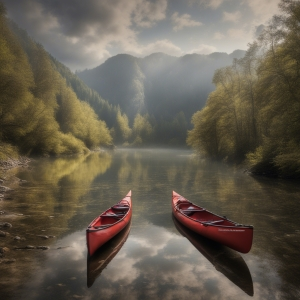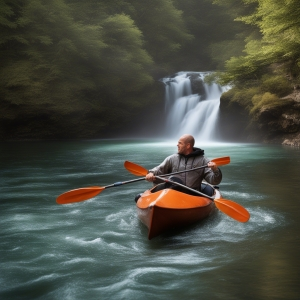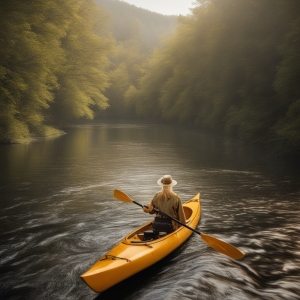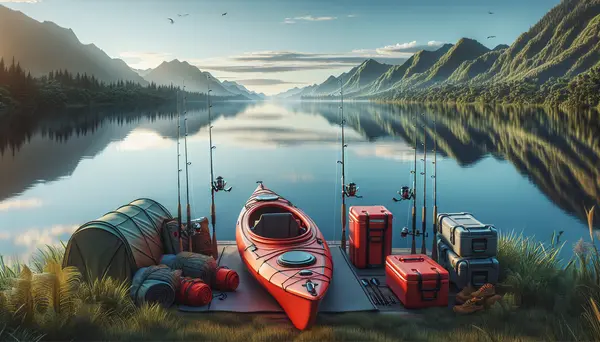Table of Contents:
Introduction to Kayak Fishing Adventures
Kayak fishing is more than just a hobby; it's an adventure that melds the beauty of nature with the thrill of the catch. If you're new to the sport, you're in for a treat. Picture yourself silently gliding through the water, surrounded by peaceful scenery, rod in hand and anticipation buzzing in the air. There's something intensely satisfying about navigating calm waters on a kayak while fishing. Kayak fishing adventures are an enriching outdoor activity that combines the tranquility of kayaking with the excitement of angling. In this article, we will guide you on how to embark on your first kayak fishing adventure.
Choosing the Right Kayak for Fishing
Your kayak should be your trusty companion in your fishing journey, so finding the right one is crucial. Here are several factors to consider: design— you will find two prominent styles, sit-on-top and sit-in, each offering unique benefits; size—consider your height, weight, and the kind of waters you will be exploring; stability—look for kayaks with good stability, essential for fishing; storage—you will need sufficient space for your fishing gear; and weight capacity—ensure your kayak can hold your weight plus your gear.
A good fishing kayak is well-balanced and sturdy, with plenty of room for all your fishing essentials. An additional feature to consider is an adjustable seat for prolonged comfort during your fishing expeditions.
Remember, the best kayak for you fits your needs and comfort. Don't hesitate to try out different models before making your choice.
Advantages and Disadvantages of Kayak Fishing Adventures
| Pros | Cons |
|---|---|
| Low cost: Compared to motorboats, kayaks are much more affordable. | Limited space: Kayaks have a limited storage space for fishing gear and catches. |
| Access to shallow waters: Kayaks can navigate through shallow waters where larger boats can't. | Weather dependent: Kayak fishing can be quite challenging in adverse weather conditions. |
| Healthy exercise: Paddling a kayak provides a great cardiovascular workout. | Can be physically demanding: Kayak fishing requires good stamina and strength, especially when dealing with a big fish or in strong currents. |
| Environmentally friendly: Kayaks don't cause pollution like motorboats do. | Requires skills: Kayak fishing demands a lot of skills, including stability, casting, and retrieving, which can take quite some time to master. |
Essential Gear for Kayak Fishing

Proper gear is crucial for any successful fishing trip, and kayak fishing is no different. Besides your trusty kayak, there are a few essentials you should always have with you.
First and foremost, a high-quality fishing rod and reel are a must. Consider a lightweight, durable rod that can cope with the kind of fish you aim to catch. As for reels, choose one that resists corrosion, as it will often be exposed to water.
Next, we have the paddle. A good paddle can make a world of difference in maneuvering your kayak, even in calm waters. Opt for a lightweight yet sturdy paddle for easy handling.
A personal flotation device (PFD) is non-negotiable. Safety should always be your top priority, with a well-fitted PFD being a key part of your kayak fishing gear.
Lastly, consider investing in a waterproof tackle box to keep your hooks, lines, and other fishing accessories organized and dry.
Your equipment should be optimal for you and your journey. Choosing the right gear is just as important as choosing the right kayak when it comes to enhancing your kayak fishing adventure.
Safety Measures when Kayak Fishing
Fishing from a kayak can be a peaceful and rewarding experience, but it's essential to keep safety at the forefront of your mind. One major safety aspect to consider is weather. Always check the weather forecast before heading out. Clear, calm days are perfect for kayaking. Avoid venturing into waters in severe weather or if there's a storm warning.
Equipping yourself with a communication deviceis a critical safety measure. Whether it's a smartphone or a VHF radio, having a means to call for help is vital, especially when you are kayaking alone.
Never underestimate the power of water. Even calm waters can occasionally become turbulent. A calm, steady current can change quickly, so it's crucial to learn basic kayaking skills. Adequate knowledge about paddling, capsizing and recovery will undoubtedly enhance your safety while kayaking.
Another indispensable safety tip is to always inform someone where you are going and when you expect to return. This person can alert authorities if you do not return as scheduled.
Lastly, don't forget to bring a well-stocked first-aid kit with you. Accidents can happen even to the most cautious among us, so being prepared with essential first-aid supplies can save the day.
Always remember, safety first. Kayak fishing should be a pleasant experience, and being well-prepared is a significant part of that enjoyment.
Planning Your Kayak Fishing Trip

After equipping yourself with the necessary gear, it’s time to plan your kayak fishing adventure. Start by choosing the fishing destination. There are countless serene lakes, rivers, and even ocean spots perfect for kayak fishing. However, for beginners, we recommend starting with mild, calm water bodies. You know your abilities better than anyone so choose a location that aligns with your skill level.
Next, you need to familiarize yourself with the types of fish dominant at your chosen spot. Every fishing location has its unique range of fish species. Knowing what fish are in the waters will help you select the right bait and tackle.
Consider the time of day for your fishing adventure. Early morning hours are often great for fishing as the waters tend to be calmer and fish more active. However, different fish species are active at different times of the day, so a little research can go a long way.
Familiarize yourself with kayaking and fishing laws and regulations in your chosen location. Nothing can ruin a good fishing trip faster than finding out you're not permitted to fish in your chosen spot or using incorrect fishing methods.
Lastly, remember to be respectful to the environment. Pack in, Pack out –leave no trace behind. This way, we can help preserve the natural beauty of the waters for future generations of kayak fishermen.
Planning IS the key to a successful kayak fishing trip. Being prepared will give you peace of mind and allow you to focus on catching that big one.
Tips for Navigating Calm Waters
Once you have made all the necessary preparations, the adventure begins. Navigating calm waters might seem straightforward, but there are a few techniques that can make the experience smoother and more enjoyable.
Firstly, learn the art of casting from a kayak. This might be different from what you're used to on a larger boat or from the shore. Practice your aim and try different methods to observe what works best for you.
Secondly, mastering paddling and steering your kayak is pivotal. Learn how to use your paddle to steer your kayak gently, whenever you want to adjust your direction or respond to currents. Efficient tuning of your kayak will prevent unwanted movements and give you a better chance at catching fish.
Another essential tip is to respect the ecosystem. Always remember that you are a guest in nature. Reflect that respect by disposing of your waste properly and attempting to minimize your impact on the water and its inhabitants as much as possible.
Lastly, staying patient and calm is a big part of angling. Sometimes, fish may not bite immediately. Keep your cool. Remember, fishing from a kayak is not just about catching fish, it's about enjoying the journey. Look around, take in the scenery, and enjoy the tranquility it brings to your mind.
Experience the Adventure: Kayak Fishing Destinations

Every angler has their favorite fishing spot, but when it comes to kayak fishing, the adventure extends beyond the catch. The destination is part of the experience. Kayak fishing grants you the opportunity to explore different bodies of water, from calm, serene lakes to flowing rivers and the vast open sea. Everything depends on your skill level and the type of adventure you seek.
As a beginner, starting on small flatwater bodies like ponds or quiet lakes might be best. They offer calm waters, making it easier to navigate your kayak while focusing on your fishing. Places like the US Southeast, known for its warm and tranquil lakes, or the freshwater bodies in the English countryside may serve as the perfect training ground.
As you gain more experience and confidence, you can gradually take on bigger water bodies. River fishing from a kayak is especially thrilling and rewarding. Many rivers across the world are renowned fishing destinations, like the Colorado River in the United States or the Danube in Europe.
Lastly, coastal fishing, or 'kayak saltwater fishing', should be on every seasoned kayak angler's bucket list. It offers a unique challenge and rewards with the variety of species you can catch. Popular coastal kayak fishing destinations include the coasts of Australia, South America, and Hawaii.
Remember, each fishing destination will require different gear and techniques. Always do your research and come prepared. The right destination can turn your kayak fishing journey into an adventure of a lifetime, combining the thrill of angling with the peacefulness of kayaking and the beauty of nature.
Fishing Techniques from a Kayak
Now that you're all set with your gear and safety measures, let's move onto the exciting part — fishing techniques! Unlike fishing from the shore or a larger boat, fishing from a kayak requires a slightly different approach. Remember, your movements need to be purposeful and controlled to maintain balance in the water.
Firstly, get comfortable with casting and reeling from a seated position. It may feel unusual initially, but with a bit of practice, it will become second nature. Focus on using your upper body while keeping your lower body relaxed and stable for good balance.
Next, is the drift fishing technique. This involves letting the wind and current move your kayak while your fishing line is in the water. It's a casual and relaxing way to cover a broad area without exhausting yourself paddling.
You can also try trolling, which involves casting your line behind your kayak and slowly moving through the water. This method allows you to cover large areas and is particularly effective in deep water.
Another important skill to master is anchor fishing. By using a small, portable anchor, you can stay in the same spot even if the wind or current tries to move you. This is especially useful when fishing in areas known for holding a good amount of fish.
Remember, experiment with these techniques and find out which one works best for you. With time, patience, and practice, you'll soon be catching fish like a pro from your kayak!
Conclusion: Embrace the Thrill of Kayak Fishing
As you embark on your kayak fishing adventures, remember that patience is key. Fishing is not about the number of catches you make, but the joy of being one with nature. This serene yet thrilling activity gives you the unique chance to explore breathtaking water bodies and appreciate the tranquil beauty of our planet.
Learn not just to fish but to respect the water, the weather, and the wildlife. Embrace every moment, from the calm mornings with a rod in your hand to the heart-pounding thrill when you feel that first bite. Whether you catch a fish or not, the real prize is the journey itself. So go ahead, venture into the calm waters, and discover the true charm of kayak fishing. Unleash your adventurous spirit and let the soothing sounds of nature be your best guide on this exciting journey.
Kayak Fishing Guide: Mastering Calm Waters
What equipment do I need for kayak fishing on calm waters?
You will need a suitable fishing kayak, a paddle, a personal flotation device, fishing gear (rods, reels, lines, hooks, and bait), a tackle box, a fishing license, and possibly a kayak anchor and drift chutes, especially for calm waters.
How do I navigate my fishing kayak in calm waters?
Using a paddle to move and steer the kayak, you should learn to angle the paddle for more efficient strokes. You would also want to learn how to adjust your course by using sweep strokes, draw strokes, and rudder strokes.
What are the best fishing techniques to use from a kayak in calm waters?
Top techniques include casting, trolling and even fly fishing if the kayak is stable enough. Always remember, safety should be your top priority when fishing on water, whether calm or turbulent.
Which fish species are typical for calm water environments?
In calm freshwater environments, you can typically find bass, crappie, trout, pike, and sunfish. Calm saltwater habitats might house species such as redfish, sea trout, flounder, and snook.
How do I ensure my safety while kayak fishing in calm waters?
Always wear a personal flotation device and ensure you bring along the necessary safety gear like a first aid kit, compass, map, and have a plan in case of emergencies. Also, inform someone at home of your fishing plans and expected time of return.







